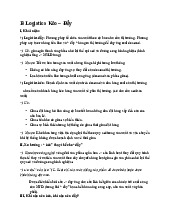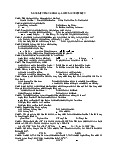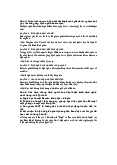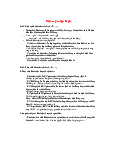






Preview text:
lOMoAR cPSD| 59780317
JOURNAL OF COMPUTERS, VOL. 7, NO. 2, FEBRUARY 2012 349
Information Integration of CPFR in Inbound
Logistics of Automotive Manufacturers Based on Internet of Things Xiaohui Liu1,2, Youwang Sun1
1 School of Transportation Engineering, Tongji University, Shanghai 201804, China
2 School of Economics and Management, Shanghai Second Polytechnic University, Shanghai 201209, China Email: 18xhliu@tongji.edu.cn
Abstract—With the improvement of supply chain
achieve large-scale development in order to let the public
management and development of information technology,
enjoy its full functions. This paper mainly studies the
the nature of business processes has changed from
information integration of CPFR model in inbound
intraenterprise to cross-enterprise. Collaborative Planning,
logistics of automotive manufacturers based on Internet
Forecasting and Replenishment (CPFR) come into being in of Things.
this case. The literature of CPFR and the Internet of Things
are discussed. The information integration of CPFR in II. LITERATURE REVIEW
inbound logistics of automotive manufacturers is analyzed.
In this section, we review the literature on information
The CPFR reference model is designed to fit many scenarios
integration of CPFR model, inbound logistics of
and this research aims to focus on the information
automotive manufacturers and the Internet of Things.
integration of CPFR model in the scenario of inbound
The literature review provides the theoretical foundation
logistics of automotive manufacturers based on the for this research.
environment of Internet of Things. Collaborative Planning, Forecasting, and
Replenishment (CPFR) was defined by the Voluntary
Index Terms—Information Integration, Collaborative
Inter-industry Commerce Standards (VICS) committee
Planning, Forecasting and Replenishment (CPFR),
as a way of describing supply chain collaboration [ 4 ]. It
Inbound Logistics of Automotive Manufacturers, Internet of Things
defined CPFR as “a collection of new business practices
that leverage the Internet and EDI in order to radically I.
reduce inventories and expenses while improving INTRODUCTION
A methodology referred to as Collaborative Planning,
customer service.” Compared with previous strategic
Forecasting and Replenishment (CPFR) has been espoused
alliances, CPFR concentrated on strongly linking
as a means of integrating all members of the supply chain.
business planning, forecasting, and replenishment
The main driving forces for CPFR adoptions there included
through deeper information sharing. CPFR provides a
fierce competition, a shorter product life cycle, offshore
good collaboration alternative based on integrating
production, and the supply chain cost structure. CPFR is a
internal and external business activities.
Web-based attempt to coordinate the various activities
Inbound logistics of automotive manufacturers is for
including production and purchase planning, demand
logistics service provider to provide timely and quick forecasting and inventory
service in accordance with the requirements of
replenishment between supply chain trading partners.[1]
automotive manufacturers, including automotive parts
Information integration has been recognized as a central
transportation, storage, handling, packaging, distribution
problem of modern database systems [ 2 ]. Information
processing, information processing and other basic
integration in supply chain refers to the sharing of
functions. Main researches are focused on the study of
information and knowledge among members of the supply
factors affecting inbound logistics of automotive
chain, including demand information, inventory status,
manufacturers and the operation modes of inbound
capacity plans, etc. Information integration efforts between
logistics of automotive manufacturers. Alan Harrison
members of the supply chain, in the form of information
summed up 6 major operation modes of automotive
sharing, synchronized replenishment, and collaborative
inbound logistics through analyzing of motor
product design and development, have been cited as major
companies.[ 5 ] Matthias Holweg and Joe Miemczyk
means to improve supply chain performance [3].
compared the implications on inbound, outbound and sea
Internet of Things was firstly mentioned by Bill Gates in
transportation logistics, leading to the development of a
his “Future” in 1995 and the idea could not really achieve
strategic framework for future automotive logistics
because of the restrictions of the technology of network operations.[6]
terminals at that time. Nowadays Internet of
The concept of Internet of Things was proposed in 1999. © 2012 ACADEMY PUBLISHER
At that time, based on Internet, RFID technology, EPC doi:10.4304/jcp.7.2.349-355
standards and on the basis of the computer Internet,
“Internet of Things” was constructed to achieve the
Internet of global real-time sharing information of the
Things once again debuts and became the focus of
physical items. This is also the first round of Internet of
national attention. However, Internet of Things is still in
Things boom in 2003. In November 2005, the International
a very early stage, and it will take a long time for it to
Telecommunication Union (ITU) released the “ITU
JOURNAL OF COMPUTERS, VOL. 7, NO. 2, FEBRUARY 2012 350
Internet Reports 2005: Internet of Things” and cited the
③Execution——to place orders, prepare and deliver
concept of Internet of Things. The report notes that Internet
shipments, receive and stock product on retail shelves,
of Things is a technological revolution that represents the
record sales transactions and make payments;
future of computing and communications, and its
④Analysis——to monitor planning and execution
development depends on dynamic technical innovation in
activities for exception conditions, aggregate results, and
a number of important fields, from wireless sensors to
calculate key performance metrics, and share insights and
nanotechnology [7]. Internet of Things is not technology
adjust plans for continuously improved results [8] .
fantasy but a technological revolution. It makes the goods
and services occurring qualitative leap. And these new
features would bring users further efficiency, convenience and safety.
III. INFORMATION INTEGRATION OF CPFR IN INBOUND
LOGISTICS OF AUTOMOTIVE MANUFACTURERS A. CPFR process model
Nowadays CPFR is being implemented at thousands of
companies across the globe. Many companies, such as
GSK, are implementing CPFR with multiple retailers. As
is shown in Figure 1, the latest version of the CPFR
guidelines, edited by the VICS CPFR committee in 2004,
is an interactive cycle of four main activities, so called Collaboration Activities:
①Strategy and planning——to establish the ground rules
for the collaborative, determine products mix and
placement, and development event plans for the period;
②Demand & supply management——to project POS
demand and order and shipment requirements;
Figure 1 CPFR Process Model[8]
between all members in supply chain, including
B. Information Flow Model of CPFR
distribution and retail activities.
In the three stages of CPFR, new information is In the planning stage, there are two things need to do: generated
depending on the data flow analysis and is for the first is to institute exception standard according to use of the next stage.
The information generated is shared historical shipment and POS data, the second is to coestablish joint business planning and project management
JOURNAL OF COMPUTERS, VOL. 7, NO. 2, FEBRUARY 2012 351
files according to all the partners‟ own strategic planning
whole channel, while the sharing mode is Sender: Member
and strategy. In the forecasting stage, the first is to A / Member B
constitute sales forecast and identify abnormal items Receiver: Hub
according to the joint business plan, POS data, unusual Data_ object: sales forecast
standards and events; the second is to establish order
Data template: XML model of sales forecast
forecast and identify abnormal project according to POS
Req_action: Generating replenishment orders Mode:
data, inventory information, sales forecasts, events, history Real-time [9]
volume of demand, product availability data and project
C. Information integration of CPFR
management files. In the replenishment stage, it is
The above information-sharing model can be used to
necessary to generate orders according to sales forecast and
address two key issues of CPFR: the inaccuracy of forecast project management.
and abnormal generated by fluctuation in supply and
Whether the information model of CPFR is simple or not
demand. Figure 3 shows the information exchange among
is in relation to the arrange ways of CPFR. The ways to
members of a traditional automotive supply chain, Figure
arrange the application of CPFR include sharing mode and
4 shows the information integration of CPFR model supply
peer to peer mode. The sharing mode appears to be more
chain and Figure 5 shows the demand information pipelines
flexible than peer to peer mode because in sharing mode
of automotive supply chain. Information integration
all members share the same database without considering
comprises information sharing and collaborative planning.
the synchronization problems of complex data. The peer to
Information sharing refers to the exchange of critical, often
peer made allows each member has its own independent
proprietary, information between supply chain members [ 10
CPFR applications and these applications can be
]. Under CPFR, inventory levels, POS data, promotion
interoperable. But the weakness in this approach is that it
plans, sales forecasts and all other information that may be
is very troublesome to realize the synchronization
influential on the market demand are shared between
exchange of data. Clearly, the peer to peer mode is more supply chain members.
suitable to type of information-sharing structure of the
JOURNAL OF COMPUTERS, VOL. 7, NO. 2, FEBRUARY 2012 352 The sales 1. Send Usage Sender: Hub
EIP——Enterprise Information Portal D——Demand
ERP——Enterprise Resource Planning S——Supply
Figure 3 Information exchange among members of a traditional automotive supply chain
EIP——Enterprise Information Portal D——Demand
ERP——Enterprise Resource Planning S——Supply
Figure 4 Information integration of CPFR automotive supply chain
D. Information Flow of CPFR in Inbound Logistics of
cooperation between automotive manufacturers and parts
Automotive Manufacturers
suppliers. The objectives of collaborative forecasting with
Collaboration is as well aspired in the automotive
suppliers and collaborative replenishment with their dealers
industry during the development process of a new vehicle.
are an increased satisfaction and enthusiasm of customers
At early stage automotive manufacturers cooperate just
which could lead to higher sales, greater profitability and
with few definite suppliers and nowadays they collaborate an improved market share.
and share explicit construction plans with their suppliers.
General Motors, the largest automotive manufacturer in
Automotive manufacturers focus more on specific
the world, used the concept of CPFR. Figure 3 highlights
customer demands and have to deal with a narrow time-
the collaborative information flow from the supplier to the
frame from an order to a delivery. So there is a need for a
customers of Demand Sensing framed by CPFR at General
high complex logistic network and a necessary flexible Motors.
EIP——Enterprise Information Portal D——Demand
ERP——Enterprise Resource Planning S——Supply
Figure 5 Demand Information Pipelines of automotive supply chain
In deciding the mode of information flow in information needs to be captured and what value and Automotive industry,
the main questions to be solved are quality has the information at each stage. Therefore, about how to identify correct
demand signals, what analyzing databases containing order information, sales
JOURNAL OF COMPUTERS, VOL. 7, NO. 2, FEBRUARY 2012 353
and inventory and click stream data should be carefully
build a simple, unobtrusive and cost-effective system of
investigated and studied. And collaborative forecasting has
item identification. RFID offers such functionality.
been investigated in order to create more visibility for
Second, data collection will benefit from the ability to
upstream suppliers and effective respond to demand
detect changes in the physical status of things, using sensor
changes on a daily basis instead of only a monthly or technologies. This is what the bar code technology cannot
weekly exchange. This is realizable by supply chain do.
partners through an exchange of relevant data, comanaging
Finally, advances in miniaturization and nanotechnology
forecast requirements and refines capacity and
mean that smaller and smaller things will have the ability replenishment plans. [10]
to interact and connect. This also contributes all the
IV. INFORMATION INTEGRATION OF CPFR IN INBOUND
“things” could be identified. [12]
LOGISTICS OF AUTOMOTIVE MANUFACTURERS BASED ON
B. Information integration of CPFR model based on INTERNET OF THINGS Internet of Things
A. Requirement for “Things” to be connected in Internet
In the above environment, information integration of
The Internet of Things is a technological revolution that
CPFR supply chain would change a lot, as is shown in
represents the future of computing and communication, and
Figure 6 and all of the “things” in supply chain will take on
its development depends on dynamic technical innovation
smart characteristics and capabilities. This will give
in a number of importation fields, from wireless sensors to
significant benefits to the integrated information
nanotechnology [12]. RFID technology, which uses radio
processing. The influences of Internet of to CPFR supply
waves to identify items, is seen as one of the pivotal enabler chain management include optimizing supply chain
of the Internet of Things. RFID technology is gradually
management process, making effective use of resources,
applied to supply chain management through arming the
realizing truly real-time management, increasing supply
“things” in supply chain with RFID devices.
chain visibility, improving the transparency of information
In the context of “Internet of Things” a “thing” could be in supply chain management and making supply chain
defined as a real/physical or digital/virtual entity that exists
management to achieve a high degree of agility and fully
and move in space and time and is capable of being integrated.
identified. Things are commonly identified either by
C. Information integration of CPFR in Inbound Logistics
assigned identification numbers, names and/or location
of Automotive Manufacturers Based on Internet of Things
addresses [11]. The “things” in supply chain include raw
Inbound logistics of automotive manufacturers is very
materials, semi-finished products, products etc.
complex especially nowadays cars are manufactured
In order to guarantee all of the “things” in supply chain specific to the customer‟s needs. The forecasting of
could be fitted with RFID devices, the following
accurate demand figures in the automotive industry requirements should be met:
becomes complicated with the shorter and shorter product
EIP——Enterprise Information Portal D——Demand
ERP——Enterprise Resource Planning S——Supply
Figure 6 Information integration of CPFR automotive supply chain based on Internet of Things
First, in order to connect all the objects and devices
life cycle, the steady change of customers‟ taste, the
including raw materials, semi-finished products and inaccurately calculated demand figures which are not
products to large databases and networks, it is crucial to
shared with their suppliers. The deployment of CPFR
seems to be most feasible with Japanese car manufacturers,
JOURNAL OF COMPUTERS, VOL. 7, NO. 2, FEBRUARY 2012 354
as Toyota already developed a strong and trustful buyer-
In the automotive industry, about 70 percent of the value
supplier relationship which is crucial for the collaborative
added chain is operated at the supplier (Kleinert, 2006) so
planning and forecasting processes. Nowadays, Toyota has
the principle of cost saving through the intended
core first tier suppliers and second tier suppliers. Most of
collaboration by CPFR seems especially promising for the
the first-tier suppliers, which manufacture high value automotive sector. In order to decline inventory and apply
components tailored to Toyotas specific needs, are
continuous replenishment, transportation had to be
subsidiaries or affiliated companies. In general, the
reorganized. Re-education of plants on just-in-time
relationship between a Japanese car manufacturer and its
approach was introduced. It is a strategy to manage
suppliers present very high levels of trust so that
inventory by delivering raw material and components from
confidential information can be shared with their suppliers
the vendor immediately as they are required (International
without concerns (Emerald, 2003).
Data Group, 2007). As is shown in Figure 7, the four main
activities of CPFR in Inbound logistics of automotive
manufacturers based on Internet of Things are as follows.
dealers (POS Forecast) and analyzes the market and all 1. Strategy and planning
collected data flow in a conjointly generated Sales Forecast
The first collaborative step of CPFR in inbound logistics
visible for all parties at all times. On the one side the
of automotive manufacturers is to define the rules and
supplier can appraise the required volume of future
basic principles for the collaboration between the car
deliveries and on the other side; both parties can determine
manufacturer and the parts supplier. The car manufacturer
conjointly the appropriate delivery methods for the
must be aware of its strategic planning and the suppliers
different vehicle parts for the future collaboration. With the
have to be evaluated thoroughly. A significant purchase
help of demand planning carried out by the manufacturer
volume as well as sufficient system capabilities and a and the supplier, a combined
trustful relationship are the most important selection
Replenishment Planning is generated [12]. criteria [12]. 3. Execution
2. Demand and supply management
The third collaborative step of CPFR in Inbound
The second collaborative step of CPFR in inbound
logistics of automotive manufacturers is execution. Based
logistics of automotive manufacturers is to demand and
on the aforementioned strategic planning the Order
supply management. In order to generate a sales forecast
Generation activity is done conjointly. Then, the supplier
in terms of CPFR, data from both the automaker and its
and the car manufacturer compile their own production and
supplier are required. Based on Internet of Things, the
supply plan. However, the production and supply planning
automotive manufacturer easily collects sales data from its
process is a continuous process which is enhanced during
Figure 7 CPFR Model in Inbound Logistics of Automotive Manufacturers Based on Internet of Things[12]
JOURNAL OF COMPUTERS, VOL. 7, NO. 2, FEBRUARY 2012 355
the production. Within the same activity, the car
[8] Voluntary Interindustry Commerce Solution (VICS),
manufacturer carries out its buying or re-buying process,
“Collaborative Planning, Forecasting and Replenishment,”
as he transfers his buying requests to his suppliers.
http://www.vics.org/committees/cpfr/CPFR_Overview_US
Afterwards, the order is fulfilled while the finished -A4.pdf, 2004.
products of the car manufacturer are distributed to the
[9] Jian Peng, “Study on Information Share and Application
Integrating in Supply Chain,” Master Thesis of Chongqing
retailer and the supplier allocates his products to the car
Jiaotong University, pp. 23-25, 2007. manufacturer [12].
[10] Shaohan Cai, Minjoon June, Zhilin Yang, “Implementing 4. Analysis
supply chain information in China: The role of institutional
The fourth collaborative step of CPFR in Inbound
forces and trust,” Journal of Operation Management, Vol.
logistics of automotive manufacturers is analysis. Data 28, pp. 257-268, 2010.
from the demand and supply management will be
[11] Vermesan Ovidiu, Mark Harrison, Harald Vogt, Kostas
compared with the actual execution. Safety stocks or the
Kalaboukas, Maurizio Tomasella, Karel Wouters, Sergio
accuracy of forecast figures are checked, for instance. The
Gusmeroli, Stephan Haller, “Internet of Things Strategic
automotive manufacturer uses supplier and dealer Research Roadmap, ”
scorecards to measure the degree of target achievements.
http://ec.europa.eu/information_society/policy/rfid/docume
In order to evaluate achievements, uncover trends and nts/in_cerp.pdf.
create alternative strategies, performance management is
[12] Christine Pfeifer, Julian Hensolt, Kathrin Wolfinger, Nancy
Kornas, Steffen Erath, “Investigation of
used by both, the automotive manufacturer and the parts
Opportunities that Exist within the Automotive Supply supplier, together [13].
Chain for Collaborative Planning Forecasting and V. CONCLUSION Replenishment,”
The information integration in CPFR and the Internet of
http://www.vics.org/docs/committees/cpfr/cpfr_white_pape
Things are both focus of research in present-day society.
rs/CPFR_for_Automotive_Industry.pdf, 2008.
This paper is carried out to make analysis of information
[13] Lynn, Truss, Wu, Peiling, Saroop, Atul and Sehgal, Satish
integration of CPFR in Inbound logistics of automotive
Kumar, “Enterprise Demand Sensing in the Automotive
manufacturers based on the environment of Internet of
Industry,” The Journal of Business Forecasting, Vol. 25, no.
3, pp. 22-23, pp. 28-30, 2006.
Things. This analysis aims to provide a new vision to
research the Supply Chain Management. ACKNOWLEDGMENT
This work is supported by the Joint Research Scheme of
National Science Foundation of China and Research
Grants Council of Hong Kong (Grant No. 70731160015
and N_HKUST 612/6) and Educational Highland funds by
Shanghai Municipal Education Commission. An earlier
version of this paper was presented at 2011 International Conference on Computer Science,
Intelligent System and Environment (CSISE2011). REFERENCES
[1] Gene Fliedner, “CPFR: an Emerging Supply Chain Tool,”
Industrial Management & Data Systems, Vol.103, pp. 1422, 2003.
[2] Jeffrey D. Ullman, “Information Integration Using Logical
Views,” Theoretical Computer Science, vol.239, pp. 189210, 2000.
[3] Susan C. Kulp, Hau L. Lee, Elie Ofek, “Manufacturer
Benefits from Information Integration with Retail
Customers,” Management Science, Vol. 50, No.4, pp. 431444, 2004. [4] VICS, “Collaborative Planning Forecasting and
Replenishment Voluntary Guidelines,” available online at: www.vics.org, 2002.
[5] Alan Harrison, “Perestroika in Automotive Inbound, ”
Manufacturing Engineer, Vol.80 No.6, pp. 247-251, 2001.
[6] Matthias Holweg, Joe Miemczyk, “Delivering the „3-day
car‟—the Strategic Implication for Automotive Logistics
Operations,” Journal of Purchasing and Supply Chain
Management, Vol.9 No.2, pp.63-71, 2003.
[7] International Telecommunication Union, “ITU Internet
Reports 2005: Internet of Things,” available online at:
www.itu.int/internetofthings/ , 2005.



